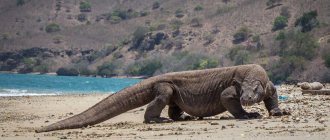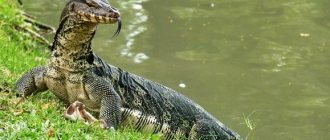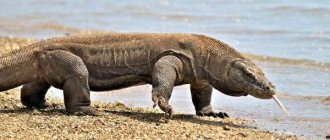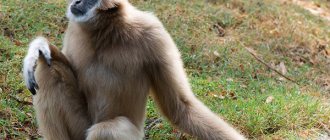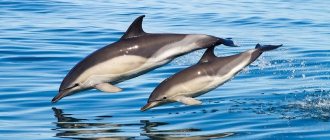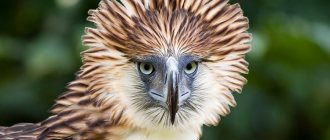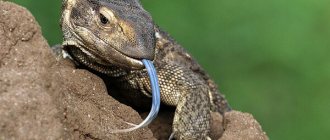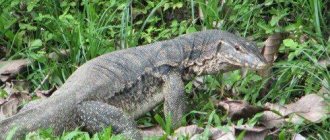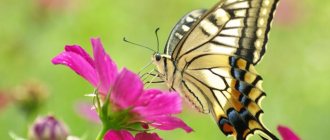15 December3714reptiles or reptilespredator dangerous endemic
The Komodo dragon is the largest lizard on our planet. It is also called the Komodo dragon. And it’s not in vain that its harsh disposition, gigantic size and poison make it a top predator and extremely dangerous not only for any animal, but also for humans. In this article you will learn the peculiarities of life and interesting facts about the Komodo dragon .
Description of the Komodo dragon and facts about his life
The description of the Komodo dragon should begin with the fact that it belongs to a species of lizards from the monitor lizard family. It is also called the Indonesian giant monitor lizard, Komodo dragon or land crocodile. This species of monitor lizard is quite ancient, because the oldest remains that have been found are over 3.8 million years old.
The appearance of the Komodo dragon is quite formidable. Its body is covered with small plate-like scales called osteoderms. The color of the Komodo dragon is dark, mostly brown, with small spots and splashes of yellow. It is worth noting that the older the individual, the darker it becomes. Young Komodo dragons often have larger yellow spots and sometimes orange or reddish spots on their backs.
The size of the Komodo dragon is impressive. Their body length is usually between 2.2 and 2.6 meters. The average weight of Komodo dragons ranges from 35 to 60 kg. An interesting fact is that males are much larger than females and individuals with a body length of 3 meters and a weight of more than 70 kg are not uncommon. In captivity, these monitor lizards grow even larger. One of the St. Louis zoos kept an individual with a body length of 3.13 meters and a weight of 166 kg.
The tail of Komodo dragons is quite long and is approximately half the length of its body. This lizard can stand on its hind legs during a hunt or when fighting with individuals of its own species. At the same time, the growth of the Komodo dragon can reach 1.4-1.5 meters, depending on the length of its body.
Komodo dragons live alone and gather in groups only for food or during the breeding season. They are awake during the daytime, although they can, if necessary, be active at night. The second half of the day is chosen for hunting.
The lifespan of these monitor lizards in the wild is up to 50-60 years. An interesting fact about Komodo dragons is that females have a life expectancy that is almost half that of males. In captivity, Komodo dragons live much shorter; there have not yet been any recorded cases of this monitor lizard living more than 25 years.
The voice of the Komodo dragon is quite specific. This animal lacks vocal cords, so it can only hiss. Sound signals are used to show irritation.
Kinds
Komodo dragons are a monotypic species. That is, it has no subspecies. But there are close relatives. One of them existed next to the Komodo dragon during its life in Australia. It was called Megalonia. It was an even larger lizard. Species name Megalania prisca. A variant translation of this name from Greek sounds like “a huge ancient tramp.”
All data on megalonium is obtained by examining the found reptile bones. Scientists have calculated the possible dimensions. They range from 4.5 to 7 meters. The estimated weight ranges from 300 to 600 kilograms. Today it is the largest land lizard known to science.
The Komodo dragon also has living relatives. A giant monitor lizard lives in Australia. It extends 2.5 meters in length. The striped monitor lizard boasts the same size. It lives on the islands of Malaysia. In addition to these reptiles, the monitor lizard family contains about 80 living and several extinct species of animals.
How does the Komodo dragon hunt and attack?
When hunting, the Komodo dragon uses almost all parts of its body: paws with huge and sharp claws, jaws with razor teeth, and even the tail. Due to the fact that half the body length of this predator is its tail, it successfully uses it as a formidable weapon. An adult Komodo dragon with a blow from its tail can break the legs of large artiodactyls, thereby depriving them of an attempt to escape or the ability to resist in any way. There was even a case described where a dog crept up to a monitor lizard from behind, and he hit it with his tail with such force and at such an angle that it flew in an arc straight into his mouth.
The skull of Komodo dragons is quite light and cannot accommodate a lot of muscle mass. It follows that the bite of these predators is almost 2.5 times weaker than that of crocodiles. For example, Nile crocodiles use the power of their jaws, grabbing their prey with them, making strong jerks with their heads from side to side, up and down, making coups, thereby tearing off huge pieces of meat and limbs from their prey. The Komodo dragon uses a different tactic: when it bites its victim, it pulls it towards itself.
The thing is that the Komodo dragon has many razor-sharp teeth, curved and jagged, similar to the teeth of a shark. By biting and backing away, the monitor lizard tears the soft tissues of its victim, causing irreparable damage to it.
Komodo dragons are quite successful hunters. Basically, they prefer an ambush style of hunting, waiting for their prey at a watering hole or in grazing areas. When attacking, the predator immediately tries to knock its prey off its feet by tearing its tendons with a bite or hitting it with its tail. If the attack is unsuccessful, the victim is pursued. The running speed of the Komodo dragon is not the most outstanding and rarely exceeds 20 km per hour. Nevertheless, he has a special sinus in his neck, which, like a pump, pumps oxygen into his lungs, allowing him to maintain maximum speed for a long time. In most cases, a wounded animal is not able to elude pursuit for long and the predator overtakes its prey.
For hunting, the Komodo dragon chooses mainly daylight hours, preferably the second half of the day. However, they can also hunt successfully at night. In the dark, for a successful attack, the Komodo dragon will benefit from an excellent sense of smell thanks to a forked tongue like a snake, with which it can smell a victim 10 km away, as well as good hearing.
Is the Komodo dragon poisonous? Yes, this predator has two glands in the lower jaw that produce poison. This toxin causes muscle paralysis and hypothermia in the victim, impairs blood clotting and lowers blood pressure, leading to shock and loss of consciousness in the victim. Of course, all this is possible only if there is an abundance of poison in the wound. For example, for a deer weighing more than 40 kg to faint, 4 mg of poison will be enough. But even with a slight ingress of toxin into the blood, the victim will feel unwell, which, combined with blood loss from the wound, reduces his chance of salvation to zero.
In addition to poison, the saliva of the Komodo dragon contains a whole host of pathogenic bacteria. When they enter a victim's wound, they can cause rapid and severe inflammation. However, there is no scientific confirmation yet that pathogenic flora in saliva helps these monitor lizards in hunting.
All these factors make an attack by a Komodo dragon deadly for anyone who gets in its way.
Symptoms
Scientists still don’t know much about the venom of the monitor lizard. It has now been established that he:
- causes blood clotting disorders;
- destroys the walls of blood vessels;
- provokes thrombus formation;
- causes the destruction of muscle tissue, which often ends in kidney failure.
Symptoms of a Central Asian monitor lizard bite:
- muscle weakness;
- difficulty breathing;
- tachycardia.
The bite of the Komodo dragon, as well as the tree one, resembles the symptoms of a viper bite:
- severe pain and redness around the wound;
- swelling of tissues;
- dizziness;
- nausea;
- chills;
- increased heart rate;
- disturbance of visual perception;
- Fainting and paralysis are possible.
If the Komodo dragon manages to inject a lot of poison, the bitten person will begin to have convulsions, develop kidney failure, internal hemorrhage and a coma.
It must be said that the reptile’s jaw does not have a developed system for injecting poison into the victim’s body, so they must clench their teeth for as long as possible, while making rhythmic biting movements. Quick and short bites, as a rule, do without negative consequences, of course, if it is not a Komodo monitor lizard.
Acute systemic symptoms may last 3 to 4 days.
Where does the Komodo dragon live?
This species of monitor lizard originated and developed in Australia, this is their historical homeland. And about 900 thousand years ago, the Komodo dragon began to populate the nearby islands. Now the Komodo dragon lives in the country of Indonesia on the islands that are part of the Lesser Sunda Islands:
- Flores, numbering about 2,000 individuals, live exclusively near the coast due to human activities.
- Komodo, estimated population 1,700 individuals.
- Rinca, with an estimated population of 1,300 individuals.
- Gili Motank, less than 100 individuals.
As a habitat, the Komodo dragon chooses mainly dry, well-warmed areas by the sun. Therefore, the Komodo dragon lives in arid plains, savannas, and dry tropical forests. Quite often this predator can be found on the coasts in search of food.
Komodo dragons are very good swimmers. They willingly enter sea water and can even swim to neighboring islands, covering enormous distances.
Young Komodo dragons live in hollows and treetops. As they mature, they begin to dig holes for shelter using their strong paws with large, sharp claws. The burrow of a Komodo dragon can be from 1 to 5 meters in length.
Enemies of monitor lizards in nature
Due to their large size, monitor lizards have not made enemies. Only young individuals are vulnerable, which can even be eaten by their own relatives. As a defense, the lizard hits the attacker with its massive tail, hisses, opens its mouth and bites very painfully.
The Salvador monitor lizard (Varanus salvadorii) is called the crocodile by the British because of the similarity of this large lizard to crocodiles
What does the Komodo dragon eat?
The Komodo dragon feeds on different animals depending on its age. Young monitor lizards hunt insects, birds and their eggs, crabs, and rodents. As they grow, the size of their hunting objects also increases. Adult Komodo dragons feed primarily on wild boar, deer and other ungulates. A large monitor lizard is capable of killing an animal 15 times its own weight. There have been cases when this lizard successfully hunted a buffalo weighing more than a ton.
In response to the smell of blood, large numbers of Komodo dragons can gather in feeding areas. In the process of eating large game, these predators have a strict hierarchy; the larger and stronger ones eat first. Feeding is accompanied by fights; they often try to kill smaller brothers and then eat larger individuals. Cannibalism among Komodo dragons is not uncommon, especially in lean years, when the diet of large monitor lizards can account for up to 10% of the food eaten by smaller fellow dragons of their species.
The Komodo dragon is very voracious; thanks to its sharp teeth and curved mouth, it is capable of biting off pieces of meat up to 2.5 kg at a time. In one sitting, monitor lizards can eat an amount of meat equal to 80% of their body weight. The prey is eaten along with bones, hooves, horns, scales, feathers, after which the monitor lizard regurgitates all undigested stomach contents along with mucus. After a meal, the Komodo dragon performs hygiene procedures, licks itself, and then wipes its mouth on the ground or vegetation.
Escorpion (Mexican serpentine)
If we compare the Mexican lizard with the Amazonian one, its size is much larger - the body grows up to 0.9 m, and the weight of large individuals reaches 4.5 kg. The tail is long, powerful, and occupies almost half of the body. They also differ in color - the escorpion is darker, yellowish stripes and spots do not form a distinct pattern. Among them there are individuals with a black or grayish-brown body color without spots. The structure of the jaw and teeth are similar.
The species of poisonous lizards lives in California on the shores of the bay, in the south of western Mexico, in Guatemala. It prefers to settle in dry, rocky areas, in grass and bushes of open forest, among stones and rocks at the bottom of canyons.
During the day they are passive and spend time in burrows they have dug or occupy empty ones. They may not crawl out into the light for several days. With the onset of darkness, the poisonous teeth leave the shelter, but they move very slowly and awkwardly, so it is difficult for them to catch up and run away.
The lifestyle, nutrition and reproduction of the Amazonian and Mexican lizards are similar. They have few enemies in nature - they should be wary of coyotes and birds of prey.
How dangerous are Komodo dragons?
Komodo dragons are dangerous to humans. Their size, sharp teeth and claws, and aggressive behavior can have lethal consequences even for an adult man. But despite all this, Komodo dragons do not regard humans as victims, only children. A Komodo dragon can attack an adult in times of hunger when there is a lack of food. An attack can be triggered by a person’s fresh wound, scratches, or recent surgery. These predators have an excellent sense of smell and, even with bandages applied, they can easily smell blood.
The islands where Komodo dragons live are not heavily populated by people. However, there are still settlements there, the number of which is steadily growing. In these regions, people often engage in agriculture, fishing, and animal husbandry. Because of the smell of fish or livestock, lizards enter villages, especially in hungry years. This leads to cases where the Komodo dragon kills a person.
It is still difficult for a Komodo dragon to kill an adult on the spot. The most common deaths are from blood loss due to wounds and medical care not provided in a timely manner. It is not uncommon for Komodo dragons to dig up fresh human graves in order to profit from dead bodies.
The Komodo dragon should never be domesticated or kept as a pet. This is a large and dangerous animal that cannot be trained and can eat its owner at any opportunity. The Komodo dragon can be kept in zoos, in specially designated and reinforced enclosures.
First aid for a monitor lizard bite
First aid for a Komodo dragon bite involves squeezing and sucking out the venom from the wound.
This should be done within 15-20 minutes. The poison should be spat out, and the mouth should be rinsed well each time with a solution of potassium permanganate or other disinfectant solution. Then the wound is treated with an antiseptic and cold is applied to it. If breathing problems occur, artificial respiration should be performed. The victim needs to be hospitalized as soon as possible.
After being bitten by a Central Asian monitor lizard, the wound should be treated with an antiseptic and consult a doctor.
What not to do
Experts strongly do not recommend immediately stopping bleeding from a wound, since the animal’s venom also flows in with the blood. It is also prohibited for the monitor lizard venom to be sucked out by a person who has wounds or broken teeth in the mouth - this way the infection can enter the blood of the first aid provider.
Reproduction of Komodo dragons
ready for reproduction from the 5th to the 10th year of its life. Moreover, very few individuals survive to this age. The ratio of males to females is very different. There are 3 or more males per female. These factors are a kind of natural regulation of population size under living conditions on the islands.
Due to the fact that there are significantly more male Komodo dragons, contractions occur during the mating period. Males engage in wrestling, stand on their hind legs, grab their opponent with their front legs and try to throw him to the ground. In such battles, the largest and strongest individuals win. Young and, conversely, old individuals become defeated, often killed and eaten.
Komodo dragons mate during the dry season in winter. After mating, females search for a place to lay eggs. To do this, they often choose the nests of local birds called bigfoot or, as they are also called, weed chicken. These birds create piles of fallen leaves that serve as incubators and aid thermoregulation during egg development. In these heaps, the female digs a rather deep hole for laying eggs. Sometimes the female digs several holes at once to distract predators, such as wild boars, who like to profit from the eggs of Komodo dragons.
In the summer, from the beginning of July to the end of August, the female Komodo dragon lays about 20 eggs. The eggs weigh approximately 200 g, are up to 10 cm long and about 6 cm in diameter. For 8 to 8.5 months, the female guards her clutch of eggs. After hatching, the small lizards immediately leave their mother and climb up nearby trees. To avoid being eaten by their adult counterparts and other predators, Komodo dragons spend the first two years of their lives mainly in the crowns of trees.
An unusual and very interesting fact about Komodo dragons is that they are capable of non-sexual reproduction, the so-called parthenogenesis. In the absence of males, the female still lays unfertilized eggs. The offspring develop and hatch, with only males being born. This phenomenon has been recorded in zoos in England. Thus, if a female ends up on an island without males, she will still be able to breed offspring there and populate it.
The Komodo dragon (also called the Komodo dragon, the giant Indonesian monitor lizard) is the largest lizard in the world, as well as one of the most effective “killers” in the animal kingdom. The homeland of these largest lizards is Australia, but the name was attached to them because of the Komodo Island, where they were probably first discovered; now about 1,600 individuals live there. These animals have also been spotted on nearby islands from Komodo Island. These Indonesian islands include: Gili Motang Island, Flores Island, Rinca Island. The total number of Komodo dragons is approximately 4,000 individuals.
Physical Description of the Komodo Dragon Komodo dragons have long tails, strong and agile necks, and strong limbs. Adult Komodo dragons are almost stone-colored. Growing monitor lizards may have brighter colors. Their tongues are yellow and forked, befitting their draconian name.
The monitor lizard's jaw and throat muscles allow it to swallow huge pieces of meat with amazing speed. Several movable joints, such as the intramandibular loop, allow the lower jaw to open unusually wide. The stomach expands easily, allowing adults to consume up to 80 percent of their body weight in a single meal, which likely explains some exaggerated claims of the enormous weight of animals ingested. When a Komodo dragon feels threatened, it may empty the contents of its stomach to reduce its weight and escape.
Although males tend to grow larger and more massive than females, there are no obvious morphological differences between the sexes. However, there does exist one small difference: a slight difference in weight distribution just at the front of the cloaca. Komodo dragon mating remains a challenge for researchers, as the dragons themselves seem to have some trouble figuring out which is which.
Size The Komodo dragon is the largest lizard living on Earth. Some recorded specimens reached a length of 3.13 meters (10.3 ft) and weighed 166 kg (366 lb). The largest wild Komodo dragons typically weigh around 70 kg (154 lb).
Habitat The habitat of Komodo dragons is limited to several Indonesian islands, the Lesser Sunda Islands, including Rinca, Padar and Flores, and, of course, Komodo Island. They live in tropical savannah forests but are widely found on islands, from the beach to the mountain tops.
Feeding Habits Their eyes can see objects very far away, up to 300 meters (985 feet), so vision does play an important role in their hunting, especially since their eyes are more focused on movement than on a variety of stationary objects. Their retinas contain only cones, so they are able to see colors but have poor vision in dim light. They have a much smaller hearing range than humans. As a result, the animal cannot hear sounds such as low-pitched voices and high-pitched squeals.
Vision and hearing are useful, but for the Komodo dragon, smell is its main food detector. The monitor lizard touches in the same way as a snake does. It uses its long, yellow, forked tongue to sample the air, after which it sticks the two tips of its tongue into the roof of its mouth, where it contacts the Jacobson's organ. Chemical “odor” analyzers recognize molecules present in the air. If there is a higher concentration on the left side of the tip of the tongue than on the right, the Komodo dragon knows that prey is approaching from the left. This system, along with a rocking gait where the head swings from side to side, helps the monitor lizard sense the presence and direction of scented carrion, up to 4 km (2.5 miles) away when there is wind.
When the Komodo dragon hunts and catches its prey, such as a deer, it attacks the legs first, throwing the deer off balance. When dealing with smaller prey, it can pounce directly on the neck. The monitor lizard's basic strategy is simple: try to take its prey to the ground and tear it to pieces. Strong muscles and powerful claws help him in this, but the Komodo dragon's teeth are its most dangerous weapon. They are large, curved and jagged and are capable of tearing flesh with great efficiency. If the deer cannot escape immediately, the Komodo dragon will continue to tear it apart. Once convinced that its prey is incapacitated, the monitor lizard can stop its attack for a short rest. At this time, the deer will be seriously injured and in shock. The monitor lizard then delivers the final blow, an attack on the stomach. The deer quickly bleeds to death and the Komodo dragon begins to eat it.
Pieces of meat, either fresh prey or carrion, will be stuck in the jagged teeth from the last meal. This protein-rich residue supports the life of a large number of bacteria. About 50 different bacterial strains have been found, at least seven of which are similar to septic tank. If the victim somehow escapes and avoids his death upon first encounter, there is a chance that his escape will be short-lived. The infections transmitted by a Komodo dragon bite will kill the victim in less than a week. In addition to bacteria in their saliva, researchers recently documented that Komodo dragons do have venom glands in their lower jaws. In addition to causing harm by the bacteria present in their saliva, their venom prevents the blood from clotting.
Video. Komodo dragon attacks on people
The dragon's bite is not fatal to other Komodo dragons. It is believed that monitor lizards, wounded by their comrades in battle, are not affected by deadly bacteria and poison. Scientists are looking for antibodies in the blood of Komodo dragons that could help save the life of an infected victim.
Large carnivorous mammals such as lions typically leave 25 to 30 percent of a carcass uneaten: intestinal contents, skinned skeleton and hooves. Komodo dragons eat much more efficiently, leaving only about 12 percent of their prey. They eat bones, hooves and even skin. They also eat intestines, but only after vigorously tearing them open to disembowel the contents.
Komodo dragons eat almost any type of meat. They rummage through rotten carcasses and hunt animals ranging in size from small rodents to large buffalos. The young mainly feed on small lizards, geckos and insects. They are tertiary predators (the predator at the top of the food chain) and cannibals. They can detect carrion from a considerable distance, about 4 km (2.5 mi), and actively search for it. When hunting, the Komodo dragon stays close to the trails, where it waits for a deer or wild boar to pass by. It then attacks the prey, most attempts being unsuccessful, causing the animal to escape. However, if the monitor lizard manages to bite its prey, the toxic bacteria and venom in the saliva will kill the prey within the next few days. After the prey dies, it can take up to four days for the animal to locate the dead body using its powerful sense of smell. As a rule, after a kill, many Komodo dragons come running for a feast and very little remains of the carcass of the killed animal.
At the Smithsonian National Zoological Park, Komodo dragons are fed a weekly diet of rodents, chickens and rabbits. They get fish from time to time.
Social Structure Because large Komodo dragons eat young, the young often fall out in feces, thereby muffling odors so that large dragons cannot smell them.
Reproduction and development Most matings occur from May to August. In a group gathered around carrion, an opportunity for courtship arises. Dominant males may be drawn into ritual fights in search of females. Using their tails for support, they fight in a vertical position, grabbing each other with their front legs, which they use to throw the opponent to the ground. Blood, as a rule, changes everything and the one who used it either continues to fight or remains submissive and motionless.
A female Komodo dragon lays about 30 eggs. Delaying styling can help avoid the dry season of the brutally hot months. In addition, unfertilized eggs may get a second chance in subsequent matings. The female lays her eggs in dug holes on mountain slopes or in the nests of greatfoots, chicken-like birds that make nests from soil mixed with twigs that can reach 1 meter (3 ft) high and 3 meters (10 ft) wide. During the maturation of the eggs (about nine months), females can lie on the nests, protecting their future offspring. There is no evidence, but the parents of hatched Komodo dragons are not involved in their care in any way.
The hatchlings weigh less than 100 g (3.5 oz) and average 40 centimeters (16 in) in length. Their first years are full of danger and they often fall prey to predators, including their own brothers. They feed on a varied diet consisting of insects, small lizards, snakes and birds. If they reach five years of age, they can weigh 25 kg (55 lb) and reach a length of 2 meters (6.5 ft). By this time, they move on to larger prey such as rodents, monkeys, goats, wild boars and the Komodo dragon's most popular food, deer. Slow growth continues throughout their life, which can last more than 30 years.
Resting Habits They escape the heat during the day and seek shelter at night in burrows that are slightly larger than them.
Lifespan In the wild, Komodo dragons live for about 30 years, but scientists are still studying this.
Study reveals how Komodo dragon kills its prey
Researchers from the University of Melbourne in Australia have discovered that the secret to its predatory success lies in its surprising venom.
Until some time, it was believed that the bite of the Komodo dragon resulted in death due to certain bacteria contained in its mouth. Due to the lightning-fast microbial attack spreading throughout the victim’s entire body, the bitten animal soon died and the monitor lizard could only wait and find the victim by its smell. After waiting for the death of the animal or the moment when it was very weakened and could not defend itself, the monitor lizard began to eat.
But Brian Fry and his team disproved this hypothesis by discovering venom glands in the animal's skull that cause severe paralysis in those who receive a reptile bite. After studying the venom, scientists found that it dilates blood vessels and prevents blood clotting, causing the victim to go into “shock.” The Komodo monster's bite is much weaker than that of a crocodile, but their prey soon dies due to blood loss caused by the deadly powerful venom that prevents blood clotting.
Fry also studied fossils of an extinct giant monitor lizard known as Megalania (Varanus prisca) to see if the species had venom glands. Their results, published in March 2009 in the American journal PNAS (English Proceedings of the National Academy of Sciences, Russian Proceedings of the National Academy of Sciences), showed that this lizard, reaching a length of seven meters, was one of the largest poisonous animals, existing on Earth.
Photo portrait of a Komodo dragon
Mouth of a Komodo dragon
Monitor lizard next to its victim
Recent known cases of Komodo dragons attacking humans In 2007, an eight-year-old boy was killed by a Komodo dragon, the first recorded fatal attack in 30 years. The attack occurred in March during the dry season, so keepers speculate that the lizard may have been particularly hungry given that the water bodies have dried up and the prey that gathers there has stopped coming to them. A Komodo dragon attacked the boy when he went into the bushes to relieve himself, local media reported.
The boy's uncle came running and began throwing stones at the lizard until it let go of his nephew. Either way, the boy died from heavy bleeding from his torso; his uncle described the boy as having two visible bite marks.
In 2008, three Britons, Kathleen Mitchinson, Charlotte Allyn and James Manning, were forced to throw stones to ward off Komodo dragons when they became stranded on the uninhabited island of Rinca in eastern Indonesia. They managed to induce fear in animals. But Anwar was not so lucky.
In 2008, a group of scuba divers on a boat were pushed far from their original dive point by the strong Flores Current. After 10 hours of spinning at high tide, the group reached the beach around midnight on what appeared to be an uninhabited island, about 25 miles from where their ordeal began. However, their troubles did not end there. They ended up on the island of Rinca, where an estimated 1,300 Komodo dragons live.
The attacks began almost immediately. The merciless lizard repeatedly attacked the Swede and bit the diver’s belt. She chewed on her belt while other divers threw rocks at the reptile's head. For two days and nights, the injured divers battled monitor lizards and tropical heat as they scraped preserved shellfish from rocks and ate them raw. Finally, the Indonesian rescue crew spotted a spotted orange emergency diver buoy placed on the rocks. Although the group of divers were in shock and recovering at a local hospital on the island of Flores, they celebrated their survival at a town bar.
In March 2009, police sergeant Cosmas Jalang reported that 31-year-old apple picker Muhamad Anwar suffered "terrible injuries" on Komodo Island. "He was working on a tree when he slipped and fell," Sergeant Jalang said. He was immobilized, lying on the ground for a short time, and then two monitor lizards attacked him. "They're opportunistic predators and he didn't stand a chance."
Miss Teresia Tawa, who worked nearby and dealt with shock after seeing the attack, said: “He was bleeding all over his body. When he fell, barely a minute had passed before the monitor lizards were on him. They just bit and bit and bit, it was terrible. They bit his arms, torso, legs and neck."
A speedboat took Anwar to nearby Flores Island, but doctors at a clinic on Flores Island were unable to save Anwar's life.
Attacks on humans by Komodo dragons, of which there are fewer than 4,000 in the wild, are extremely rare, but keepers say the number of such incidents appears to have increased in recent years.
In 2022, giant monitor lizards practically ate the body of a tourist in Thailand. At the end of April, an investigation was launched into the death of 30-year-old Belgian tourist Elisa Dallemange, whose remains were discovered on the island of Tau on April 28. The police told the victim's relatives that she had committed suicide, but Eliza's family did not believe it.
The girl's body was so badly torn apart by giant monitor lizards (not Komodo monitor lizards, giant monitor lizards are the third largest in size after Komodo dragons and striped monitors) that it could only be identified through a dental examination. The girl's parents said that in recent months she had often traveled around the world, practiced meditation and studied yoga. The last time (April 17), when the Belgian contacted her relatives via Skype a few days before her death, the girl was in high spirits and said that she was very happy to exist in unity with nature on the “paradise island.”
Her mother said: “There are too many things that show us that someone is involved. The police told us that Elise hanged herself in the jungle. I cannot accept that my daughter killed herself." Perhaps Eliza's parents' suspicions may make sense, since no suicide note was found near the girl's body. Journalists believe that Thai police will not reveal the true cause of the foreigner's death so as not to scare away tourists. From 2014 to 2017, seven people died on Koh Tao. All of them became victims of lizards, which can reach three meters in length. Their bite is toxic and often fatal.
Below is a case where a monitor lizard attacked a girl. It was not a Komodo dragon, which emphasizes that even a not so frightening monitor lizard is capable of inflicting wounds on a person.
Goanna clings to 8-year-old girl's leg On January 24, 2022, a young girl was forced to rush to hospital after a huge goanna bit her on a Queensland beach. An eight-year-old girl was left with a “frightening” wound to her leg after it took two people to free her from the jaws of a lizard at a campsite on South Stradbroke Island.
Photo. Snake catcher Tony Harrison with a goanna that attacked an 8-year-old girl
"This was a very disturbing incident," Queensland Ambulance Service Chief Inspector Janey Shearman told reporters. “While walking around the campsite she was attacked by a goanna which caused quite a nasty cut. It was quite difficult to get the goanna off the baby and it took a couple of people to get it off the leg.”
When the girl was taken to Gold Coast University Hospital for treatment of a deep wound to her leg, Shearman described the attack as “savage”.
Experts say goanna bites can be dangerous because the carnivores feed on carrion and toxic bacteria in the mouth can cause pain, swelling and prolonged bleeding caused by the bites.
Below you can see a documentary about the investigation of Komodo dragon attacks on people called: “In the Mouth of the Dragon.” The film examines a case in which a boy named Mansur was attacked by a Komodo dragon on Komodo Island. It was only thanks to the quick reaction of his uncle Jafar that the Komodo dragon abandoned its prey and disappeared from sight, but the worst was only yet to come. The boy died from loss of blood just 30 minutes later. The film also mentions an incident that occurred in 1974 with the famous German hunter, Baron Rudolf von Reding, who was eaten by a Komodo dragon during a walk. There is also a story from the head of the marina, Yvon Pariman, who was attacked by a monitor lizard when he lay down to rest on his bed with socks in his house (the Komodo monitor lizard grabbed his leg with socks). Yvon was lucky, despite his wounds and fever, he survived.
This entry was posted on Saturday, October 25, 2014 - 12:40 pm. You can leave a comment.
Why is the Komodo dragon on the verge of extinction?
The Komodo dragon is listed in the International Red Book and is endemic, that is, it lives exclusively on the islands of Indonesia. Although the population of these animals is considered stable, especially on large islands, it is nevertheless declining. In order to protect the species from extinction, Komodo National Park was created in 1980. It now organizes tours of both scientific and entertainment nature. Therefore, it is impossible to say that the Komodo dragon is on the verge of extinction.
The reason why the number of Komodo dragons has significantly decreased is human activity. Especially due to tourism, destruction of the food supply, as well as human settlement of the animal’s habitats and its prey. For example, on Padar Island the population of the Komodo dragon has completely disappeared and this species has not been here since 1975. Presumably the reason for this was the extermination of large animals here by poachers, which the Komodo dragons fed on.
In addition to humans, nature itself poses a threat to the preservation of the number of Komodo dragons. Volcanic activity in the region, earthquakes, and forest fires pose a threat to the life of both the predator itself and its food supply.
Don’t forget to subscribe to updates on our website and join us on social networks (Vkontakte, Odnoklassniki, Instagram) so you don’t miss anything and always stay up to date with all the news!
Don't forget to share with your friends!
Dangerous lizards
Which lizards are poisonous? The most dangerous lizards are considered to be: the serpentine, which can be found in the South-West of the United States of America, and its relative, the Mexican serpentine, found in the forests of western Mexico. The venom of such reptiles is extremely dangerous, but, as a rule, these representatives extremely rarely attack people themselves. Most often, it is the person trying to catch a poisonous lizard who becomes the culprit of the poisonous teeth attack.
At the very bottom of the oral cavity they have 8 poisonous glands, in which a dangerous toxic substance is produced. The poison is evenly distributed over the teeth of the lizards and during the bite is injected into the body of the victim. Venom teeth cling very strongly to their opponent, sometimes it is almost impossible to tear the reptile away from the victim. The toxin that gets from the teeth into the wound has a paralytic effect and causes severe intoxication.
Photo of the poison-tooth lizard:
Attention! If such a lizard bites a person, the latter is unlikely to die, since the amount of the toxin itself is sometimes not enough to cause death.
